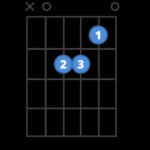The guitar and piano, while both keyboard instruments in a broader sense, offer vastly different approaches to harmony and musical texture. On the piano, note arrangement is linear, dictated by pitch. However, the guitar presents a “functional” layout. This means notes that are harmonically related – a fourth or a third apart – are often physically close on the fretboard. This fundamental difference shapes how we create music on each instrument, particularly when it comes to chord voicings and techniques frequently heard in Popular Guitar Songs.
One of the defining characteristics of guitar playing, especially in popular music, is the ability to create chord voicings and arpeggiated patterns that span a wide harmonic space. Imagine a picking pattern like the one in Simon & Garfunkel’s “Scarborough Fair.” This intricate, interwoven melody and harmony is remarkably easy to execute on the guitar, thanks to its functional layout. Attempting the same pattern on the piano would be significantly more challenging and feel unnatural due to the linear arrangement of notes. The guitar’s design encourages patterns where the fingers of the left hand can establish a chord shape, while the right hand can weave through the strings, creating a rich, textured sound that fills the harmonic spectrum in a unique, often “fractured” way.
Arpeggios, the broken chords that are a staple in many popular guitar songs, further illustrate this point. On the piano, arpeggios generally follow a more ordered, sequential pattern. Guitar arpeggios, however, can be far more “out-of-order,” jumping across strings and intervals in ways that would be cumbersome on the piano. This freedom allows guitarists to create arpeggiated lines that are both harmonically interesting and physically comfortable to play, contributing to the distinctive sound found in countless popular guitar tracks.
Conversely, the piano excels at stacking chords with close intervals like thirds and seconds. These smaller intervals, readily accessible on the piano’s linear keyboard, lead to denser, more complex chord voicings that are a hallmark of piano music. Guitar chord culture, while certainly capable of complexity, often leans towards a different approach. Guitarists frequently prioritize a strong bass note foundation and are less concerned with meticulously crafting every note within a chord shape. The physical limitations and ergonomic considerations of the guitar fretboard often dictate chord shapes. If certain notes are omitted or doubled within a guitar chord voicing, it is often accepted, even embraced, as part of the instrument’s inherent character, contributing to the raw and sometimes imperfect charm found in popular guitar music.
Chord inversions, which are crucial for smooth harmonic movement on the piano, are handled differently on the guitar. Piano chord inversions are more structurally defined. You can’t simply start an arpeggio anywhere within a chord shape and expect it to sound musically coherent in the same way you can on guitar. The sustained nature of the piano also plays a role. While sustain can be beautiful, applying heavy sustain to guitar-like picking patterns on the piano can often result in a muddy, less defined sound compared to the clarity and articulation achieved on the guitar.
Interestingly, transcribing pieces originally written for other instruments, like Bach’s violin solo sonatas, onto the guitar reveals these harmonic differences further. These complex works translate surprisingly well to the guitar, highlighting the instrument’s capacity for handling intricate, spread-out voicings. The violin, tuned in fifths (even wider intervals than the guitar’s fourths), naturally lends itself to this type of harmonic thinking. This “spread-apart” approach to harmony, where notes are not always tightly clustered, is a defining feature of guitar music and contributes significantly to the open, airy textures often heard in popular guitar songs. It’s an “art of painting harmonies by omission,” where the spaces between notes are just as important as the notes themselves. This technique is widely employed on the guitar and is a key element in creating the captivating harmonic landscapes that define so many popular guitar songs across genres.

